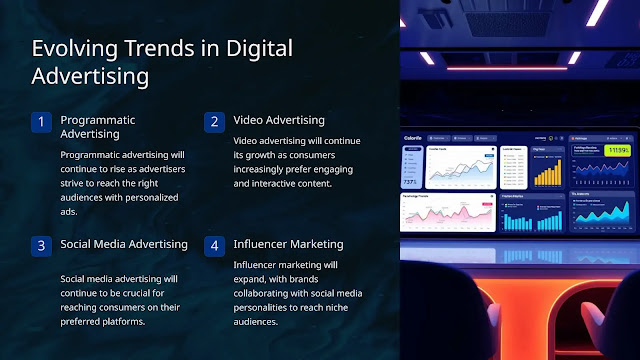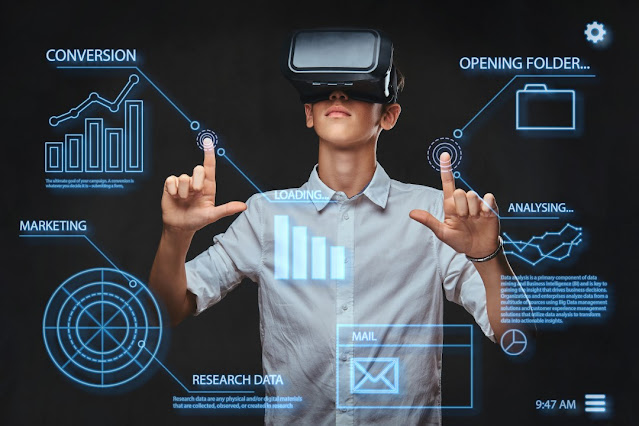Scope Of Digital Marketing in 2025

The Scope Of Digital Marketing in 2025
The scope of digital marketing in 2025 is expected to expand to include a wider range of technologies and platforms. Some trends that are expected to shape the future of digital marketing include:


The evolving trends in digital marketing are shaped by rapid technological advancements, shifting consumer expectations, and the increasing demand for personalized, immersive experiences. Artificial Intelligence (AI) and machine learning are transforming how brands engage with customers by enabling hyper-personalization through data analysis and predictive insights. This allows real-time optimization of campaigns to target consumers more accurately.
Voice search and conversational AI are rising in importance, with chatbots and virtual assistants becoming key tools for customer engagement and service. Meanwhile, augmented reality (AR) and virtual reality (VR) are revolutionizing e-commerce by offering immersive, interactive shopping experiences, such as virtual try-ons and product demos.
Video content, especially short-form formats like those on TikTok and Instagram Reels, continues to dominate, while live streaming and social commerce are growing sales channels, integrating shopping directly into social platforms.
The focus on sustainability and social responsibility is intensifying, with brands being expected to showcase ethical practices and contribute to social causes. Influencer marketing is evolving, with a shift towards micro and nano influencers who offer greater authenticity and engagement. Finally, data privacy remains a priority as stricter regulations shape how marketers collect and manage consumer information, prompting a move toward more transparent, ethical marketing strategies.
The rise of personalized content and targeted campaigns is reshaping digital marketing, allowing brands to create more relevant, engaging experiences for consumers.
Personalized Content
Personalization is driven by AI and machine learning, which enable marketers to analyze vast datasets, including browsing history, location, purchase behavior, and social media interactions. With this data, brands can craft content tailored to individual preferences, offering product recommendations, personalized emails, and dynamic landing pages. Personalized content increases user engagement by making the customer feel understood, fostering loyalty and improving conversion rates. By addressing the specific needs of each customer, brands enhance their relevance and build deeper emotional connections.
Targeted Campaigns
Targeted campaigns use consumer data to deliver precise marketing messages to the right audience at the right time.
Dynamic re targeting is one popular method, where ads are tailored based on a user’s previous actions, like browsing a product but not purchasing. Marketers can also segment their audience into smaller, more specific groups, ensuring that campaigns are highly relevant to each segment. These targeted strategies minimize ad spend waste and improve ROI by focusing resources on those most likely to convert.
Together, personalized content and targeted campaigns empower brands to meet consumer expectations for more meaningful, customized experiences, strengthening brand loyalty and driving better business results.

Digital marketing refers to the promotion of products or services through digital channels such as search engines, social media, email, websites, and mobile apps. It leverages online platforms and data-driven strategies to reach and engage target audiences, build brand awareness, drive traffic, and generate leads or sales.
Key Components of Digital Marketing:
1. Search Engine Optimization (SEO):
- Improving a website's visibility on search engine results pages (SERPs) organically.
2. Content Marketing:
- Creating and distributing valuable, relevant content to attract and engage a target audience (e.g., blogs, videos, eBooks).
3. Social Media Marketing:
- Promoting content, products, or services on platforms like Facebook, Instagram, LinkedIn, and Twitter.
4. Email Marketing:
- Sending personalized, targeted messages to nurture relationships and drive conversions.
5. Pay-Per-Click Advertising (PPC):
- Paid ads on search engines or social platforms that charge per click (e.g., Google Ads, Facebook Ads).
6. Affiliate Marketing:
- Partnering with affiliates to promote products or services in exchange for a commission.
7. Influencer Marketing:
- Collaborating with influencers to leverage their reach and credibility.
8. Analytics and Data:
- Using tools like Google Analytics to track performance, measure ROI, and refine strategies.
9. Mobile Marketing:
- Optimizing campaigns for mobile devices, including SMS marketing and app-based advertising.
10. Video Marketing:
- Using platforms like YouTube or TikTok to engage audiences through video content.
Benefits of Digital Marketing:
- Global Reach: Access to a worldwide audience.
- Cost-Effective: Lower costs compared to traditional marketing.
- Targeted Audience: Advanced segmentation for precise targeting.
- Measurable Results: Real-time tracking and analytics.
- Interactivity:Two-way communication with customers.
Adapting to the digital marketing landscape requires businesses to adopt flexible, data-driven strategies. Here are key strategies businesses can implement:
1. Define Clear Goals
- Identify specific objectives (e.g., brand awareness, lead generation, sales).
- Use SMART criteria (Specific, Measurable, Achievable, Relevant, Time-bound).
2. Understand Your Audience
- Conduct market research to identify target demographics.
- Develop buyer personas to tailor messaging and campaigns.
- Monitor audience behavior and preferences using tools like Google Analytics or social media insights.
3. Build a Strong Online Presence
- Website Optimization:
- Ensure mobile-friendliness, fast loading times, and user-friendly navigation.
- SEO:
- Use keyword research, optimize meta tags, and produce high-quality content.
- Social Media Profiles:
- Maintain active and engaging profiles on platforms where your audience is active.
4. Invest in Content Marketing
- Publish blogs, videos, infographics, and eBooks to provide value.
- Focus on evergreen content that remains relevant over time.
- Leverage storytelling to connect emotionally with your audience.
5. Leverage Data and Analytics
- Use analytics tools to track campaign performance and customer behavior.
- Adjust strategies based on insights like conversion rates, engagement, and ROI.
- Implement A/B testing to optimize ads, emails, and landing pages.
6. Embrace Social Media Marketing
- Identify platforms where your target audience is active (e.g., LinkedIn for B2B, Instagram for B2C).
- Use paid ads to increase reach.
- Engage with followers through comments, polls, and direct messages.
7. Personalize Customer Experience
- Use customer data to deliver tailored recommendations, emails, and offers.
- Implement dynamic content that adapts based on user behavior.
- Create remarketing campaigns to re-engage potential customers.
8. Diversify Marketing Channels
- Balance efforts across SEO, social media, email, PPC, and affiliate marketing.
- Experiment with emerging platforms like TikTok or new ad formats.
- Adopt an omnichannel approach for seamless customer interactions.
9. Emphasize Video Marketing
- Invest in short-form videos (e.g., reels, Tik Toks) and long-form content (e.g., webinars).
- Optimize videos for SEO on platforms like YouTube.
- Incorporate live streaming for product launches or Q&A sessions.
10. Stay Updated with Trends
- Keep up with emerging technologies like AI, VR, or AR.
- Monitor algorithm changes on search engines and social media.
- Stay agile and willing to experiment with innovative approaches.
11. Focus on Customer Retention
- Use loyalty programs and exclusive offers.
- Send personalized follow-ups post-purchase.
- Encourage user-generated content and reviews.
12. Monitor Competitors
- Analyze competitor strategies and identify gaps in their approach.
- Differentiate your offerings through unique selling points (USPs).
The scope of digital marketing in 2025 is vast and continues to grow as businesses increasingly rely on digital channels to connect with their audiences. Several factors and trends are shaping the field, making it an essential aspect of modern business strategies.
Key Factors Driving the Scope of Digital Marketing in 2025
1. Increased Digital Penetration
- Global internet users are expected to rise further, increasing digital audiences.
- Smartphone adoption and affordable data plans will expand reach, especially in emerging markets.
2. Advancements in Technology
- AI and machine learning are revolutionizing personalization, content creation, and automation.
- Augmented Reality (AR) and Virtual Reality (VR) are enhancing customer engagement, especially in retail and real estate.
3. Evolving Consumer Behavior
- Consumers demand seamless, personalized, and fast online experiences.
- Voice search, conversational AI, and smart devices are influencing how users interact online.
4. Growth of E-Commerce
- Online shopping is becoming the norm, leading to more investment in e-commerce marketing.
- Direct-to-Consumer (DTC) brands are leveraging digital platforms to bypass traditional retail.
5. Data-Driven Strategies
- Businesses rely heavily on analytics to make data-driven decisions, optimize campaigns, and enhance customer experience.
- The role of privacy-focused data collection methods will expand, driven by regulations like GDPR.
6. Rise of New Platforms and Formats
- Emerging platforms like TikTok, Threads, and BeReal are becoming essential marketing tools.
- Interactive and immersive content, such as shoppable videos, will dominate campaigns.
Key Areas of Growth in Digital Marketing
1. Artificial Intelligence and Automation
- AI-powered tools for chatbots, predictive analytics, and programmatic advertising.
- Enhanced personalization through AI-driven insights.
2. Content Marketing
- Video content, including short-form and live streaming, will dominate.
- Interactive content such as polls, quizzes, and AR experiences will drive engagement.
3. Social Media Marketing
- Niche platforms and communities will offer new opportunities for targeted marketing.
- Influencer marketing will grow, with a focus on micro and nano-influencers.
4. Voice Search Optimization
- Optimizing for voice-activated devices like Alexa, Siri, and Google Assistant.
5. Sustainability Marketing
- Consumers increasingly prioritize brands that promote eco-friendly practices.
- Digital campaigns will highlight sustainable and ethical practices.
6. Global Reach with Localization
- Brands will focus on localizing content for global audiences.
- Multilingual SEO and culturally relevant marketing will be critical.
7. Customer Experience (CX
- Businesses will emphasize seamless, omnichannel experiences.
- AI and chatbots will enhance customer service and engagement.
8. Privacy and Ethical Marketing
- Compliance with privacy laws and ethical use of consumer data will shape strategies.
- Marketers will invest in first-party data collection methods.
Future Trends in Digital Marketing
1. Metaverse Marketing
- Virtual worlds and metaverse platforms will offer immersive branding opportunities.
- Businesses can host virtual events, create virtual stores, and use NFTs for engagement.
2. 5G Impact
- Faster internet speeds will enable high-quality video streaming, AR/VR, and real-time interaction.
- Mobile marketing strategies will evolve with 5G capabilities.
3. Hyper-Personalization
- AI will enable hyper-personalized content, offers, and experiences.
- Predictive analytics will anticipate customer needs before they arise.
4. Blockchain in Marketing
- Ensuring transparency and trust through blockchain-based advertising and contracts.
- Potential for decentralized social platforms.
Opportunities for Professionals and Businesses
- For Professionals:
- Growing demand for digital marketing specialists, data analysts, and AI experts.
- Upskilling in areas like SEO, AI tools, and social media will be essential.
- For Businesses:
- Increased ROI on digital marketing investments.
- Enhanced ability to reach global markets while maintaining personalized connections.
Conclusion
In 2025, digital marketing is more integral to business success than ever. With emerging technologies, shifting consumer preferences, and global digital adoption, businesses that embrace these opportunities and adapt to trends will remain competitive and thrive








Comments
Post a Comment